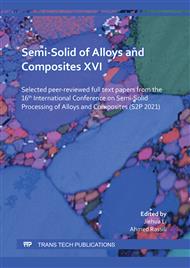[1]
J Sheng, J Z Zhou, S Huang, et al. Characterization and tribological properties of micro-dent arrays produced by laser peening on ZCuSn10P1 alloy. The International Journal of Advanced. 76 (2015) 1285-1295.
DOI: 10.1007/s00170-014-6344-z
Google Scholar
[2]
A Moharami. Improving the dry sliding-wear resistance of as-cast Cu-10Sn-1P alloy through accumulative back extrusion (ABE) process. Journal of Materials Research and Technology. 9 (2020) 10091-10096.
DOI: 10.1016/j.jmrt.2020.07.022
Google Scholar
[3]
F A González, J D Val, R. Comesaña, et al. Laser cladding of phosphor bronze. Surface & Coatings Technology. 313 (2017) 248-254.
DOI: 10.1016/j.surfcoat.2017.01.097
Google Scholar
[4]
L L Fan, M Y Zhou, Y W X Zhang, et al. The semi-solid microstructural evolution and coarsening kinetics of AZ80-0.2Y-0.15Ca magnesium alloy. Materials Characterization. 154 (2019) 116-126.
DOI: 10.1016/j.matchar.2019.05.019
Google Scholar
[5]
D B Spencer, R Mehrabian, M C Flemings. Rheological behavior of Sn-15 Pct Pb in the crystallization Range. Metallurgical and Materials Transactions B. 3 (1972) 1925-1932.
DOI: 10.1007/bf02642580
Google Scholar
[6]
M C Flemings. Behavior of metal alloy in the semi-solid state. Metallurgical and Materials Transactions B. 22 (1991) 269-293.
Google Scholar
[7]
X Zhang, Y Wang, D R Liu, et al. Effect of stirring rate on grain morphology of Mg-Al alloy semi-solid microstructure by phase field lattice Boltzmann simulation. Journal of Crystal Growth. 543 (2020) 12504.
DOI: 10.1016/j.jcrysgro.2020.125704
Google Scholar
[8]
H T Zhang, L L Fan, M Y Zhou, et al. Effects of semi-solid treatment by electro-magnetic induction on micro-microstructure evolution and mechanical properties of the Mg-2.4Y-4Nd-0.5Zr-1Ni alloys. Materials Research Express. 7 (2020) 056506.
DOI: 10.1088/2053-1591/ab8c73
Google Scholar
[9]
J F Jiang, Y Wang, J J Qu, et al. Microstructure evolution of AM60 magnesium alloy semisolid slurry prepared by new SIMA. Journal of Alloys and Compounds. 497 (2010) 62-67.
DOI: 10.1016/j.jallcom.2010.02.099
Google Scholar
[10]
Z Y Wang, Z S Ji, M L Hu, et al. Evolution of the semi-solid microstructure of ADC12 alloy in a modified SIMA process. Materials Characterization. 62 (2011) 925-930.
DOI: 10.1016/j.matchar.2011.07.003
Google Scholar
[11]
M Cao, Q Zhang, K Huang,et al. Microstructural evolution and deformation behavior of copper alloy during rheoforging process. Journal of Materials Science & Technology. 42 (2020) 17-27.
DOI: 10.1016/j.jmst.2019.09.036
Google Scholar
[12]
J Wang, H Xiao, L B Wu, el al. Study of Rolling-Remelting SIMA Process for Preparing the Semi-Solid Billet of ZCuSn10 Alloy.Acta Metallurgica Sinica. 50 (2014) 567-574.
DOI: 10.4028/www.scientific.net/ssp.217-218.418
Google Scholar
[13]
M Cao, Q Zhang, Y S Zhang. Effects of plastic energy on thixotropic microstructure of C5191 alloys during SIMA process. Journal of Alloys and Compounds. 721 (2017) 220-228.
DOI: 10.1016/j.jallcom.2017.05.245
Google Scholar
[14]
Y K Li, R F Zhou, L Li, et al. Microstructure and Properties of Semi-solid ZCuSn10P1 Alloy Processed with an Enclosed Cooling Slope Channel. Metals. 8 (2018) 275.
DOI: 10.3390/met8040275
Google Scholar
[15]
Q P Wang, R F Zhou, J R Guan, et al. The deformation compatibility and recrystallisation behaviour of the alloy CuSn10P1. Materials Characterization. 174 (2021) 110940.
DOI: 10.1016/j.matchar.2021.110940
Google Scholar
[16]
T Noda, K Qikawa, S Itoh. Thermodynamic evaluation of Cu-Cu3P system based on newly determined Gibbs energy of formation of Cu3P. Calphad. 33 (2009) 560-577.
DOI: 10.1016/j.calphad.2009.03.005
Google Scholar


